saturday 2hr ride worked great have a 15 minute video have to edit it to get it off my phone. tested suspension in all ways almost laid the machine on its side, nothing to do with suspension just a steep side hill definitely going to put an air tank on it ordering a .5 gal tommorrow best take a way is the ability to jack the front end up down hill to avoid bottoming out i needed to run around 125 psi it seemed like to keep out of most of the rocks bearing in mind this was a rocky trail we have another trail in another canyon nearby that is like riding on bowling balls the rock crawlers test out their machines there that is where i will go next to see how it does. i went out with two guys one has a razor the other has a new cfmoto . they commented on how the wheels stayed on the ground thru the ups and downs of the trail the guy with razor filmed the decent. the trail would have been defined as max difficult in some places due to trail erosion. i noticed that the machine does not rise equally so to make big changes from a flat state on the trail would take some time . it needs over 100psi before it starts picking up the heavy side of the machine i hope the jack tank will make air up take less time to equal out glad to hear about not running them flat i let the air out when i put it in the pickup it did not bounce around at all and i couldnt even tell it was in the truck but i wont let it flat completely any more after reading your post. one thing i have learned is that there is a price to pay for comfortable seating on a 50 inch machine and that is center of gravity i noticed that comparing the seat height in the cfmoto and the honda. the honda was some where around 8 to 10 inches higher and that makes a difference when it comes to side hills on a wider machine probably not a big of an issue. but on the trail size machines it is. i think i understand why honda lowered the ride height in 2017. what i need is two machines one for knarly riding and one to take my wife on easier rides i love the honda on all points just have to be aware of the tip over factor at all times in difficult trail situations. over all the ride was excellent. making changes on the trail was slow i am guessing the jack tank will solve that. i will have to add another fill and bleed switch to iso late the jack tank from the shocks in the see each other position. no big deal i wont need one the expensive clippard valves to do that. soon as i figure out the video editing i will post it . and post the tank install when i get it done.Ya, the only 'Y's I found did not go down to the 1/8 tubing. Did you see the push-lock manifolds that parker has? I forgot to mention that you can heat the tubing a bit with a hair dryer or heat gun to form permanent bends. With a little practice, you can conform the tubing to the frame or anything else for that matter. I did that with mine where there was no choice but to make a tight turn, or relieve stress at the fittings, or you can add additional 90's. I think the manifold I'm using has like 10 ports. For the ports I haven't used, I just cut a short piece of tubing and heat fused one end, and stuck it in, so if I want to add more air driven stuff, I have ports available. I can see where you ran your short lines from the shocks to the T fittings down to the frame. I looped my shock tubes so they cross each-other up to a T on the upper frame so it's a nice gentle turn straight into the T fitting. Have you taken it for a ride yet?
You are using an out of date browser. It may not display this or other websites correctly.
You should upgrade or use an alternative browser.
You should upgrade or use an alternative browser.
Sounds like it did really well the first ride out. Says alot about the install- nice! Make sure your tank is rated for the 200psi.. and go with a bigger one if you can fit it- there's a ton of space under the drivers seat. I think the tank does make the system respond quicker due to having a bit of a reservoir to get things moving as soon as you open the valves. When I know I'm going to be juggling pressure due to terrain, I always bleed the tank down until the compressor kicks on, and let it fill to max pressure. It takes a bit of practice, but it works so good when you figure out what it takes to make your machine react the way you want it to. You need taller tires, and a little wider- huge difference in stability- just a couple inches, and gives the suspension more versatility. Sounds like it's a good thing you went with the 200psi compressor.saturday 2hr ride worked great have a 15 minute video have to edit it to get it off my phone. tested suspension in all ways almost laid the machine on its side, nothing to do with suspension just a steep side hill definitely going to put an air tank on it ordering a .5 gal tommorrow best take a way is the ability to jack the front end up down hill to avoid bottoming out i needed to run around 125 psi it seemed like to keep out of most of the rocks bearing in mind this was a rocky trail we have another trail in another canyon nearby that is like riding on bowling balls the rock crawlers test out their machines there that is where i will go next to see how it does. i went out with two guys one has a razor the other has a new cfmoto . they commented on how the wheels stayed on the ground thru the ups and downs of the trail the guy with razor filmed the decent. the trail would have been defined as max difficult in some places due to trail erosion. i noticed that the machine does not rise equally so to make big changes from a flat state on the trail would take some time . it needs over 100psi before it starts picking up the heavy side of the machine i hope the jack tank will make air up take less time to equal out glad to hear about not running them flat i let the air out when i put it in the pickup it did not bounce around at all and i couldnt even tell it was in the truck but i wont let it flat completely any more after reading your post. one thing i have learned is that there is a price to pay for comfortable seating on a 50 inch machine and that is center of gravity i noticed that comparing the seat height in the cfmoto and the honda. the honda was some where around 8 to 10 inches higher and that makes a difference when it comes to side hills on a wider machine probably not a big of an issue. but on the trail size machines it is. i think i understand why honda lowered the ride height in 2017. what i need is two machines one for knarly riding and one to take my wife on easier rides i love the honda on all points just have to be aware of the tip over factor at all times in difficult trail situations. over all the ride was excellent. making changes on the trail was slow i am guessing the jack tank will solve that. i will have to add another fill and bleed switch to iso late the jack tank from the shocks in the see each other position. no big deal i wont need one the expensive clippard valves to do that. soon as i figure out the video editing i will post it . and post the tank install when i get it done.
accidently deleted video. going on vacation 10 days with a lot of trail riding it will be a good test for the suspension. i will get some videos to post. my sway bar has been removed prior to the air ride mod. by the way i am going on a fall color cruise up the east coast in october for ten days if i get any where close to where you live i might be able to stop in and visit for bit.Looking forward to the video! Sway bar removed, right?
Where are you going for the color cruise? I will definitely be doing H/M trails this fall with a group of guys and family from Canada. Love to meet ya in person! Looking forward to the vids, and hope your set-up works fantastic for you! Are you still running stock tires? I changed mine out with less than 20 miles on the machine, so I'm kinda curious about how well the stockers hold up.accidently deleted video. going on vacation 10 days with a lot of trail riding it will be a good test for the suspension. i will get some videos to post. my sway bar has been removed prior to the air ride mod. by the way i am going on a fall color cruise up the east coast in october for ten days if i get any where close to where you live i might be able to stop in and visit for bit.
Has anyone tried the front shocks off of the 2017 p5? i understand they have variable rate springs and are adjustable
The '17's definitely ride better. I bought a full set of the '17 shocks to put on my '15, just haven't installed them yet. I think my employee price on all 4 was about $300, maybe just a few bucks more. There are usually some on e-bay which are around $80 some dollars each.
I got the '17 front shocks for about $160 and put them on my '15 p500. Used the softest setting. Made a noticeable improvement.Has anyone tried the front shocks off of the 2017 p5? i understand they have variable rate springs and are adjustable
Lose 1" of ride heightHas anyone tried the front shocks off of the 2017 p5? i understand they have variable rate springs and are adjustable
advertisement
How do you know they ride better if you haven't installed yet? Have you ridden a machine with those shocks?The '17's definitely ride better. I bought a full set of the '17 shocks to put on my '15, just haven't installed them yet. I think my employee price on all 4 was about $300, maybe just a few bucks more. There are usually some on e-bay which are around $80 some dollars each.
906UP
Well-Known Member
Lifetime Member
Supporting Member
Club Contributor
He said "The '17's definitely ride better"..... I would assume this means he's ridden a 2017 to compare to his 2015 modelHow do you know they ride better if you haven't installed yet? Have you ridden a machine with those shocks?
trigger
Old Ironsides
Vendor
Lifetime Member
Supporting Member
He said "The '17's definitely ride better"..... I would assume this means he's ridden a 2017 to compare to his 2015 model
Pretty sure he works at a Honda dealership?
I have a 2015... I put 2017 shocks on (Canadian safety replacement Shocks).He said "The '17's definitely ride better"..... I would assume this means he's ridden a 2017 to compare to his 2015 model
They do make a "noticeable improvement"
I shortly after replaced those shocks and did jak9922 's front shock modification shock replacement....
There was much more than a "noticeable" difference.... It was a different machine. Ten times better difference than those kyb Honda replacement shocks..
The air system looks like the best result.... But for simplicity , results and low cost Jak's front shock solution is in my opinion the way to go... Look at the early pages of this thread.
Air shocks- 4 (2 kits for front) $160. (lifetime warranty on shocks if you buy them from Autozone) Valve and fittings $40. Bushings and bolts $20. No cutting/moving mounts, no welding. Total invested $200 for the most basic set-up if you do all yourself. Switch back to stock shocks takes 20 minutes. I don't know if that's cheaper, but I hope it helps y'alls decision making processI have a 2015... I put 2017 shocks on (Canadian safety replacement Shocks).
They do make a "noticeable improvement"
I shortly after replaced those shocks and did jak9922 's front shock modification shock replacement....
There was much more than a "noticeable" difference.... It was a different machine. Ten times better difference than those kyb Honda replacement shocks..
The air system looks like the best result.... But for simplicity , results and low cost Jak's front shock solution is in my opinion the way to go... Look at the early pages of this thread.
Both the JWB air system and Jak's method are much better ways of improving your suspension!Air shocks- 4 (2 kits for front) $160. (lifetime warranty on shocks if you buy them from Autozone) Valve and fittings $40. Bushings and bolts $20. No cutting/moving mounts, no welding. Total invested $200 for the most basic set-up if you do all yourself. Switch back to stock shocks takes 20 minutes. I don't know if that's cheaper, but I hope it helps y'alls decision making processI've done the 'full monty' on mine and have spent almost $900
The 2017 shocks are a very marginal improvement at best.
jwb the air suspension worked great for me 125 psi all around seemed to give clearance and a decent ride i did notice something weird though i had lowered one side on a mild side hill to see how it worked.it worked well however when i aired back up only the left side went up i had to shut the left side down and air up only the right side to even out machine. my wife weighs more than i do and i am about 220lb so i dont know if that had some thing to do with it the other anomaly is, airing up machine empty rocking it back and forth to level. when taking off for the ride it seemed like it would lean to the right slightly so i would let some air out of the left rear to level it, then one other time we were heading back to camp in a rainstorm and i noticed the front was low when the air pressure was at 125psi all around, the trail was basically flat i stopped and dumped and aired up system again, had no problems have you experienced this? i am thinking this is a condition brought on by the fact that there are no height control valves to shut the air off to a shock when it reaches a level based on pressure. they make these for the air ride on trucks but the install would be a can of worms plus a cheap valve is about 80.00 each so i dont think i will do any thing about it, short of learning and compensating by the fill valves on the dash. i wasnt able to get any videos but i thought it performed well. i bought a set of two inch spacers today for it . i think i will put my sway bar back in and do a test ride and see what the ride difference is i am going on ride in august that will be mostly easy i am going to put the spacers on when the ride is not on 50 in trails, which during vacation i found two 50 in trails that the forest service had took out the gates too, and were allowing 60 and up 66in wide machines on go figure if they are going to widen them out i would have bought a wider machine for stability. pictures of the view from skyline trail central utah about 10000feet elevationAir shocks- 4 (2 kits for front) $160. (lifetime warranty on shocks if you buy them from Autozone) Valve and fittings $40. Bushings and bolts $20. No cutting/moving mounts, no welding. Total invested $200 for the most basic set-up if you do all yourself. Switch back to stock shocks takes 20 minutes. I don't know if that's cheaper, but I hope it helps y'alls decision making processI've done the 'full monty' on mine and have spent almost $900
regards
bikeman
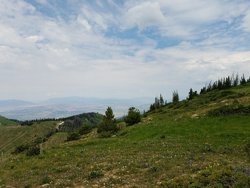
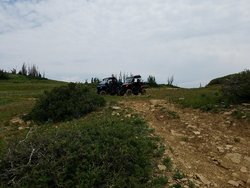
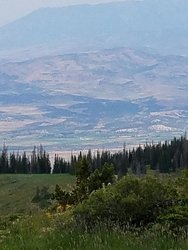
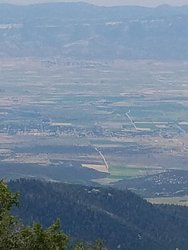

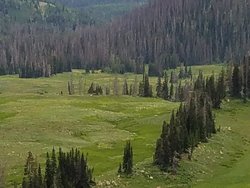
Last edited:
Love the pictures man! That's why I love my P5 so much!! Everything you said about air pressure and ride height is confirming my decision to not pay attention to air pressure numbers. I still don't have a pressure gauge on mine, but I just know what pressure my compressor shuts off at-125. I don't have mine loaded as heavily as yours, so most of the time 125 is enough. I have never had to run that much in my front shocks- they would be 'topped out' all the time. I usually start with max pressure (125) in the rears due to my average load, and roughly 80 in the fronts- before me and my girl get in. Then we ride, and I just adjust pressure according to conditions- I usually end up adding more to the rears by overriding my pressure switch with the manual switch, and I pay close attention to the fronts- adding more air if spongy or bottoming, or listening for the the shocks 'topping out'- they make a kind of metallic 'clank' that you can hear, and feel in the steering wheel, and bleed off just a touch of pressure a little at a time as I ride. Once I get them all set for the conditions/terrain, I sometimes tweak a corner as needed to compensate for better load leveling. It's all by feel. Keep in mind that when you are airing back up after dropping one side, the corner with the lightest load will always come up first. Just add air to the low corner until it evens out. Don't get caught up in gauge numbers- they're dam near irrelevant once the machine is moving with a load. Interesting that you mention the rear sway bar, cause I was thinking of doing the same, due to having to add a lot of pressure to the rears when I'm riding fast and doing a lot of fast corners to reduce body roll. Considering that the rears have far less effect on ride comfort and articulation than the fronts, It might just end up being a really good combination. I have to replace two cv boots and one of my steering rack boots- parts will be here next week- maybe I'll reinstall the rsb too. One other thing to mention, that might be causing you issues. The control arm bushings do not rotate with the movement of the control arms, so, if the bolts were tightened with the control arm down, the teeth in the ends of the bushing bite into the frame and make the bushing act like a torsion spring as the control arm is pushed up, and the converse applies as well. When I was doing my shock install, I loosened all the control arm bushing bolts, centered the control arms in their travel, and re-tightened. I'm going to install washers or something along those lines, and not tighten the bolts to the point where it squeezes the mounts against the bushings, to allow the control arms to travel freely. This should improve articulation even more, and allow the shocks to have even more control over the suspension.jwb the air suspension worked great for me 125 psi all around seemed to give clearance and a decent ride i did notice something weird though i had lowered one side on a mild side hill to see how it worked.it worked well however when i aired back up only the left side went up i had to shut the left side down and air up only the right side to even out machine. my wife weighs more than i do and i am about 220lb so i dont know if that had some thing to do with it the other anomaly is, airing up machine empty rocking it back and forth to level. when taking off for the ride it seemed like it would lean to the right slightly so i would let some air out of the left rear to level it, then one other time we were heading back to camp in a rainstorm and i noticed the front was low when the air pressure was at 125psi all around, the trail was basically flat i stopped and dumped and aired up system again, had no problems have you experienced this? i am thinking this is a condition brought on by the fact that there are no height control valves to shut the air off to a shock when it reaches a level based on pressure. they make these for the air ride on trucks but the install would be a can of worms plus a cheap valve is about 80.00 each so i dont think i will do any thing about it, short of learning and compensating by the fill valves on the dash. i wasnt able to get any videos but i thought it performed well. i bought a set of two inch spacers today for it . i think i will put my sway bar back in and do a test ride and see what the ride difference is i am going on ride in august that will be mostly easy i am going to put the spacers on when the ride is not on 50 in trails, which during vacation i found two 50 in trails that the forest service had took out the gates too, and were allowing 60 and up 66in wide machines on go figure if they are going to widen them out i would have bought a wider machine for stability. pictures of the view from skyline trail central utah about 10000feet elevation
regards
bikeman
View attachment 49499 View attachment 49500 View attachment 49501 View attachment 49502 View attachment 49503 View attachment 49504
Last edited:
Love the pictures man! That's why I love my P5 so much!! Everything you said about air pressure and ride height is confirming my decision to not pay attention to air pressure numbers. I still don't have a pressure gauge on mine, but I just know what pressure my compressor shuts off at-125. I don't have mine loaded as heavily as yours, so most of the time 125 is enough. I have never had to run that much in my front shocks- they would be 'topped out' all the time. I usually start with max pressure (125) in the rears due to my average load, and roughly 80 in the fronts- before me and my girl get in. Then we ride, and I just adjust pressure according to conditions- I usually end up adding more to the rears by overriding my pressure switch with the manual switch, and I pay close attention to the fronts- adding more air if spongy or bottoming, or listening for the the shocks 'topping out'- they make a kind of metallic 'clank' that you can hear, and feel in the steering wheel, and bleed off just a touch of pressure a little at a time as I ride. Once I get them all set for the conditions/terrain, I sometimes tweak a corner as needed to compensate for better load leveling. It's all by feel. Keep in mind that when you are airing back up after dropping one side, the corner with the lightest load will always come up first. Just add air to the low corner until it evens out. Don't get caught up in gauge numbers- they're dam near irrelevant once the machine is moving with a load. Interesting that you mention the rear sway bar, cause I was thinking of doing the same, due to having to add a lot of pressure to the rears when I'm riding fast and doing a lot of fast corners to reduce body roll. Considering that the rears have far less effect on ride comfort and articulation than the fronts, It might just end up being a really good combination. I have to replace two cv boots and one of my steering rack boots- parts will be here next week- maybe I'll reinstall the rsb too. One other thing to mention, that might be causing you issues. The control arm bushings do not rotate with the movement of the control arms, so, if the bolts were tightened with the control arm down, the teeth in the ends of the bushing bite into the frame and make the bushing act like a torsion spring as the control arm is pushed up, and the converse applies as well. When I was doing my shock install, I loosened all the control arm bushing bolts, centered the control arms in their travel, and re-tightened. I'm going to install washers or something along those lines, and not tighten the bolts to the point where it squeezes the mounts against the bushings, to allow the control arms to travel freely. This should improve articulation even more, and allow the shocks to have even more control over the suspension.
went on a 60 mile ride sat went down a trail that was so washed out from the heavy winter that the machine was sliding against the door and lower roll cage tubing in places i dropped one side and it leveled out the machine other places it did not matter the ruts were well over a foot deep, the machine could not tip over because the wheels were against the side of the rut. the air ride worked well didnt rip out any air lines i am going to change up to 1/4 air lines to the wye of each corner to see if i can speed up the reaction time when i make radical changes in height to one side or the other of the machine when i dropped air the other guys in the group thought that they were having tire blow outs until they remembered about my suspension it was a lot of work to manipulate it in the middle of the rut i would be cool if it could react faster i have been looking at hydraulic and air cylinders to see if they might react faster and to see if they would work as the suspension using air pressure only. always got to be fiddling with the machine, a guy at work says why dont you just ride it. i know one thing for sure i am going to get taller tires with more edge grip as soon as i get some money saved up. ground clearance is the key thing on one of these machines when you get into rough trails. i didnt get a video of the trail i was too busy getting thru it. it was a blast. we did not have time to go back up it on the way back home. before i go on the cruise this fall i will get your phone number and give you a call if i get any where near where you live.
bikeman
bikeman
advertisement
Similar threads
P500
P5 Safety Harnesses
- Hoosier1960
- Pioneer 500/520 Accessories and Modifications
- Replies
- 14
- Views
- 1K
- Replies
- 30
- Views
- 2K
- Replies
- 14
- Views
- 782
- Replies
- 2
- Views
- 422

